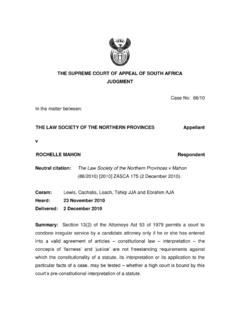Transcription of SOUTH AFRICAN POLICE SERVICE BASIC AND SPECIALISED ...
1 SOUTH AFRICAN POLICE SERVICEBASIC AND SPECIALISED TRAINING OVERVIEWThe Vision of the SAPS: Human Resources Development Division To ensure quality education, training and development (ETD) in support of creating a safe and secure environment for all people in the Republic of SOUTH Africa. The Mission of the SAPS: Human Resources Development Division To invest in human capital throughinnovative and quality education, trainingand development (ETD) of all employeesof the SOUTH AFRICAN POLICE SERVICE ,promoting lifelong learning, in support ofeffective SERVICE delivery. BASIC POPK9 TRTNIUSTFI ntensity andskillsHighLowTraining intensity and skill level escalates as thethreat level increasesSpecialised operations: International and national interest hostage release and counterterrorismTRTNIUSTFHigh-risk operations CIT (open-air robberies) Barricaded suspects Dangerous arrest warrants Dangerous/difficult search warrantsMedium-risk operations Rapid response operations Arrest warrants with a medium threat Search warrants with medium difficultyPOPP ublic order operations Crowd management Restoring public unrest Restoring serious public violenceCourtesy.
2 Lt Col Scott, STFBASIC POLICE DEVELOPMENT LEARNING PROGRAMMEBASIC POLICE DEVELOPMENTSOUTH AFRICAN POLICE SERVICETHE PURPOSE OF BASIC POLICE TRAINING8To enable newly appointed POLICE officials to use a series of legal and policing skills to protect and serve members of communities in terms of the Constitution of SOUTH Africa, 1996 (Act No 108 of 1996). provide a more effective SERVICE , which will improve community satisfaction and put them in a position to fulfil their mission of creating a safe and secure environment for all who live in SOUTH Africa. EXIT LEVEL OUTCOMES9On completion of this BASIC training, the learner will be able to -1. balance the constitutional and legal rights of individuals with the competence to legally infringe those rights in the SERVICE of maintaining a safe and secure society.
3 2. evaluate policing principles and their application in relation to crime prevention. 3. conduct a criminal investigation by gathering information and evaluate situations and select tactical techniques and skills needed to perform policing duties and maintain the safety of the self and others. EXIT LEVEL OUTCOMES (continued)5. support a criminal prosecution by preparing documents and giving evidence in a court of law. 6. apply the principles of operation and SERVICE delivery within a Client SERVICE Centre (CSC) in a policing environment. 7. maintain professional conduct to enhance the principles of SERVICE delivery to the community. 10 The target group for BASIC POLICE Development sentry-level recruits are constablesThe duration of the learning programme: 24 months Academy phase - 12 months Workplace learning phase - 12 monthsBASIC POLICE DEVELOPMENTLEARNING AREAS OF THE BTLPLA 1: Orientation to the SAPSLA 2: LawLA 3: Community SERVICE CentreLA 4: Crime InvestigationLA 5: Crime PreventionLA 6: Street Survival12 THE PURPOSE OF LEARNING AREA 1To orientate the learner on how to conduct himself/herself in a professional manner in a policing environment and to introduce the SAPS culture to the POLICE DEVELOPMENTL earning Area 1.
4 Orientation to the SAPST rainees are trained in professional conduct, includingdiscipline, command and control, and team Health and Wellness(EHW) is also addressed toenable the trainees to cope with the stressful situations they areto be confronted with as they perform their has a module that particularly deals with selfmanagement and anger Rights forms a golden thread in the programme and ispresented in all the learning POLICE DEVELOPMENTL earning Area 2: LawFocusing on equipping the trainees with aspects of law, particularly Criminal Law. The Criminal Procedure Act, 1977 (Act No 51 of 1977) is presented. Issues related to effecting an arrest are dealt with in all learning areas. The use of force and how to effect an arrest in terms of Section 49(2) of the Criminal Procedure Act, 1977 (Act No 51 of 1977) are dealt with extensively.
5 BASIC POLICE DEVELOPMENTL earning Area 6: Street SurvivalThe use of force is also addressed when firearm and tactical training are presented to the trainees. Exercising alertness during policing tasks to ensure the safety of POLICE officials and the public through preventative initiative and tactical preparation during policing techniques of tactical personal equipment safely to ensure safe and lawful performance of policing use of force tactical decisions that meet legal and organisational the principles of the use of force to ensure safe and lawful performance of policing POLICE DEVELOPMENTF irearm training is presented throughout the training in terms of the Firearm Control Act, 2000 (Act No 60 of 2000). All trainees are trained in the safe handling and practical shooting of the following firearms: 9mm pistol, an R5 rifle and a general aspects applicable to all firearms are dealt with in the training, as well as the fundamentals of shooting.
6 Trainees are exposed to tactical and street survival techniques, tactical aspects with regard to tactical awareness, the carrying of firearms in certain situations and conditions of firearms, when attending to POLICE DEVELOPMENTC rowd Management is presented theoretically in the Crowd Management presented at this level is for the firstresponders in crowd management before SPECIALISED trained the relevant legislation/legal aspects of crowd crowd forming and actions by the first member(s) in the crowdthat is the firstpolice member s/members responsibilities at thescene of the spontaneous crowd the use of force in crowd management POLICE DEVELOPMENTIn Crowd Management, the trainees are also trained to understand the relevant legislation. The Regulations of Gatherings Act, 1993 (Act No 205 of 1993) together with SO (G) 262 are discussed with the trainees.
7 A reference is also made to sections 10, 11, 12 , 16, 17, 18 and 36 of the Constitution, which refers to the right to human dignity (section 10), the right to life (section 11) , the right to freedom of expression (section 12,16), the right to assemble, demonstrate, picket and hand over petitions (section 17), the right to association (section 18) and limitation of the rights (section 36).PRACTICAL SHOOTING During the workplace learning phase, physical fitness and shooting practise on all firearms are undertaken. If levels decline, trainees are given remedial training on the specific problem areas through ORDER POLICEESTABLISHMENT AND TRAINING The Constitution of the Republic of SOUTH Africa,1996 (Act No 108 of 1996) The right to the existence of the Public Order POLICE units is founded in the Constitution. In terms of section 17(1) of the SOUTH AFRICAN POLICE SERVICE Act, 1995 (Act No 68 of 1995), the National Commissioner will, subject to section 218 (1)(K) of the Constitution, establish and maintain a national public order capacity.
8 The mandate of Public Order Policing is toprovide security and stabilise solutions forcrowdmanagementandcrowdunrestsituatio ns, where classic policing strategies arenot equipped to deal with the situation. Responsible for maintaining Public Order performing crowd management combating public violence stabilizing of serious and violent crime incidents giving SPECIALISED operational support The rendering of SPECIALISED assistance to Divisions, iedetectives, border POLICE and VIP ProtectionADMINISTRATIVE POLICY: DIVISION VISIBLE POLING :THEFUNCTIONINGOF PUBLIC ORDER POLICE (POP) 3/1/5/1/174 dd 2008-11-18 CROWD MANAGEMENT CURRICULUMP latoon membersThe Crowd Management curriculum consists of the following five modules and is presented over 3 weeks:Module 1: Legal FrameworkModule 2: Preparing for Crowd Management IncidentsModule 3: Crowd Management EquipmentModule 4: Crowd Management TechniquesModule 5: Crowd Management Operations Module 1.
9 Legal Framework The Constitution of the Republic of SOUTH Africa, 1996 (Act No 108 of 1996), the SOUTH AFRICAN POLICE SERVICE Act, 1995 (Act No 68 of 1995) The Regulation of Gatherings Act, 1993 (Act No 205 of 1993) SO (General) 262 Module 2: Preparing for Crowd Management Incidents Crowd dynamics Conflict resolution Scale of use of force Constitutional powers of the POLICE Deadly force Tactical communication Equipment and use of resourcesModule 3: Equipment Helmet Gas mask and filter Body armour Tonfa Shield Musler shotgun and double-ball rubber rounds Pepper spray CS (tear gas) CS rifle grenades and 40mm CS rounds Stun grenades Other pyrotechnical aids (coloured smoke grenades, flares) B&T 40mm grenade launcherModule 4: Crowd Management Techniques Techniques on foot Platoon and section formations Indoor techniques Vehicle formations Principals and rules of intervention Legality Optimisation (optimal use of equipment) Situational appropriateness (my actions must solve the problem, not create a bigger one) Proportionality (are my actions proportional to the threat) Shooting range shotgun with double-ball rubber rounds Tactical options Defensive Offensive Block protestorsSearch Isolate Pushback C hanneli seEvacuate EscortEncircle Patrol DisperseModule 5.
10 Crowd Management Operations Definitions and abbreviations of crowd management Conventional signs related to crowd management Briefing and debriefingAssessmentFormative and summative assessments are used to assess the understanding of the course content, application of the knowledge and behavioural change of the DOG HANDLERS INTRODUCTION The safety and security of all inhabitants of our country is the responsibility of the SOUTH AFRICAN POLICE SERVICE (SAPS). This includes the deterrence of crime, the investigation of all crimes and participation, in effect, to establish the root causes of crime. POLICE dogs are a huge aid in this regard. THE TRAINING OF POLICE DOGSP atrol Dog Handlers Training Course (four months) and Tactical Dog Handlers Course (three weeks)Sniffer and SPECIALISED Dog Handlers Training Course (five months) and Tactical Dog Handlers Course (two weeks)PATROL DOG HANDLERS TRAININGC urriculum Obedience Apprehending armed/dangerous suspects Searching for suspects in an open area or buildings Averting an attack Practical tracking Searching for articles Retrieving an object PATROL DOGS ARE TRAINED TO - follow a human trail and indicate what objects contain a human scent at a crime scene.

















